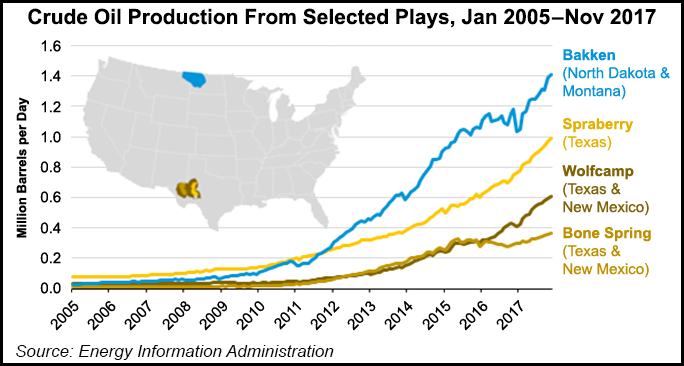E&P | NGI All News Access | NGI The Weekly Gas Market Report
U.S. Crude Oil Production in November Hits 10M b/d, Highest Level Since 1970, EIA Says
U.S. crude oil production, boosted by record high output in Texas, reached 10.038 million b/d in November, the highest level since the record 10.044 million b/d achieved in November 1970, according to the Energy Information Administration (EIA).

It was the first time domestic crude production has surpassed 10 million b/d since 1970, EIA said in its latest Petroleum Supply Monthly report, which was released Thursday.
Crude oil production in Texas reached a record high 3.89 million b/d in November, EIA said. Production in North Dakota was 1.18 million b/d. In the U.S. Gulf of Mexico, production was 1.67 million b/d, a 14% increase compared with October as the region continued to recover from Hurricane Nate.
“U.S. crude oil production has increased significantly over the past 10 years, driven mainly by production from tight rock formations including shale and other fine-grained rock using horizontal drilling and hydraulic fracturing to improve efficiency,” EIA said. “EIA estimates of crude oil production from tight formations in November 2017 reached 5.09 million b/d, surpassing a previous high of 4.70 million b/d in March 2015…
“Liquid production — both crude oil and condensate — from tight rock currently accounts for about 51% of total production. A decade ago, in November 2008, production from tight formations accounted for only 7% of total U.S. production. Non-tight oil production has been mostly constant over the previous decade.”
After increasing relatively steadily since 2011, tight oil production began to decline after the West Texas Intermediate (WTI) oil price decreased from $105/bbl in June 2014 to a low of $30/bbl in February 2016, EIA said. WTI prices were about $60/bbl last month.
Even during those price fluctuations, production continued to increase in three Permian Basin formations — the Spraberry, Bone Spring, and Wolfcamp — and in the Bakken formation in the Williston Basin in North Dakota and Montana, the agency said.
In a recent report, the International Energy Agency (IEA) said it expects U.S. crude oil production to exceed 10 million b/d this year, surpassing output from Saudi Arabia and rivaling that of Russia. IEA Executive Director Fatih Birol has said he expects the United States will become the world’s top producer of oil and natural gas over the next several decades.
Speaking at the World Economic Forum last week, U.S. Energy Secretary Rick Perry indicated that he doesn’t necessarily take as gospel IEA’s projections. Perry also dismissed suggestions that U.S. production would reach 14 million b/d by 2021, but begin to decline by around 2024, ostensibly because the United States wouldn’t be able to maintain that level of production.
The seemingly inexorable upward trend of oil and natural gas production from the seven most prolific U.S. onshore unconventional plays is likely to continue in February compared with January, according to EIA. Total oil production in the seven plays is expected to increase to an estimated 6.55 million b/d in February, compared to 6.44 million b/d in January, an increase of about 111,000 b/d, EIA said.
© 2024 Natural Gas Intelligence. All rights reserved.
ISSN © 2577-9877 | ISSN © 1532-1266 | ISSN © 2158-8023 |
